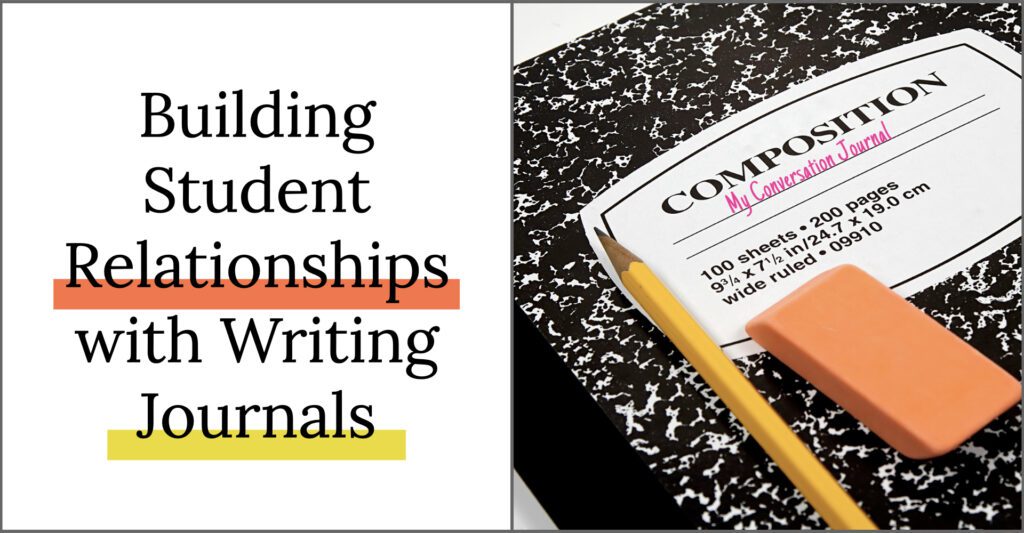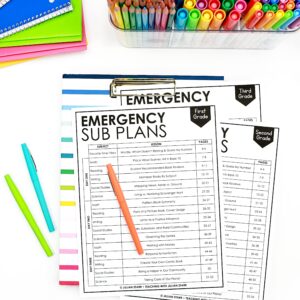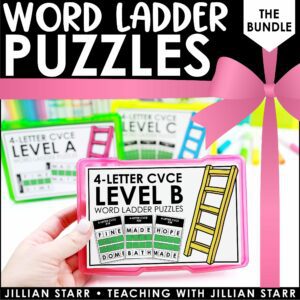
Building positive relationships with our students is critical to their success in our classroom. There are so many ways to build relationships, but many have been made more challenging lately as we work to remain masked and socially distanced. However, one of my absolute favorite ways to spark and maintain those relationships can be used under any circumstances: journaling.
What is journaling? Well, it may be the single most useful tool I use in my classroom, and I’m going to break it down for you from start to finish.
Setting Up For Journal Success
On the first day of school, I show students a stack of journals. What you say next is critical to making the whole thing work! Here’s my usual spiel:
“When there are many children in a classroom, it can be hard for you to feel like you get to have my attention as often as you would like to. Sometimes, you want to tell me something, but I am busy working with a small group. Sometimes, you want to ask me a question, but you don’t want to ask it in front of the whole class. Sometimes, what you need to tell me feels too hard to say out loud, so you keep it to yourself. Well, these journals are a great way to have some one-on-one time with me. I will write back to you EVERY week. I like to think of these journals as our own private conversations.
You can write to me about ANYTHING you want. Tell me anything that you think I should know. Tell me about what excites you. Tell me about what bothers you. Tell me about what is hard for you. Tell me about what you are proud of. Tell me about what you do after school and on the weekends. Tell me about a problem you’re having. Tell me about your friendships. Ask me questions. Let me get to know you, and if you want, get to know me.
These are private conversations. I will not show these to your grown-ups. They are not for anyone’s eyes but yours and mine. These journals are a safe place. Nothing you write will hurt my feelings. I want you to be honest and I want you to feel comfortable telling me anything. I love you, and nothing you write will change that.”
Make Journals A Routine
I leave 40 minutes open every Friday afternoon for Journaling. (When I taught first grade, I started with 10 minutes at the beginning of the year and slowly built up to 30 minutes by the end of the year.)
I always read all of their journal entries before school on Monday morning. If I don’t have time in school on Friday after school, I take my bag of journals home with me. I do this for a few reasons, but mostly because sometimes students share very important information that I may need to know ASAP.
A student might be bullying them, a parent might be sick, a grandparent may have passed away, they may be nervous about reading groups, they may be struggling with a friendship… and their journal is where they felt comfortable sharing that it’s happening. I don’t want a FULL week to go by before I’m aware of this.
I do not REPLY to every journal by Monday morning. I love my weekends and do my best to leave work at work. Instead, I try to reply to a few each day, and by Friday I have responded to all of them in time to pass them back.
I return their journals on Friday afternoons with my responses inside. I leave privacy boards/partitions out because some students want to ensure that their writing stays between us. They take the first few minutes reading my messages to them and reviewing their previous journal entry.
Once they’re done reading through my responses, they can choose to continue the previous conversation, or begin with a new topic. And then it starts all over again!
Expect a Variety of Student Writing
Whether I’m teaching first grade or third grade, there is always a wide range of what these journal entries will look like. For the first few months in first grade, many of my students drew pictures of what they wanted to share and labeled their drawings. Others were able to write complete sentences or even several sentences at a time.
In third grade, the variety is more in the content, but there is still a range of writing abilities. Each student uses the journals for what they need most. A lot of my students use it as a way to fill me in on the details of their home life. For example, a student might want to let me know that her father, who still lives in Korea to support their family, was coming to visit!
Some need a way to connect with you every week, and have found it! I had a student who wrote to me every week about the New England Patriots! Nobody in their family was a football fan, so he likes to chat about stats, great plays, and their favorite players.
I also have students who just want to share their ideas with you- inventions that they have created, suggestions for you to improve your teaching, or things that are working for them in the classroom.
And sometimes, they just want to love you and see if they can make you smile (little kids trying to tell jokes are the best!)
How to Respond
Most of the time our conversations are light and fun. They share little nuggets about themselves and I work hard to make personal connections with them by sharing things we have in common, or connections I have to their writing. I also make sure to ask them questions to keep the conversation going?
- How was your soccer game against the Eagles?
- Did you do anything special for your mom’s birthday? Did she love your present?
- What was your favorite part of the movie? Was it similar to the book?
- Did your goggles fall off during the swim meet this time?
- What’s your favorite part about being a big brother?
- What did you do with your cousins when they came to visit?
However, sometimes what they share can be a bit heavier. Sometimes students will share a painful memory. Other times they will entrust you with an ongoing problem at home or school. Sometimes they will ask you questions that you may be uncomfortable answering.
My advice? Respond truthfully, validate their feelings, thank them for trusting you, and make decisions about how much to go into on a case-by-case basis.
Important Reminders
The lack of structure in what they write about is important! This allows students to us what’s important to THEM, instead of what WE deem important. Allowing our students to start the conversation builds trust and validates their feelings and experiences.
Regardless of what a student writes about, it was likely *the most* important thing on their mind at that time. We need to treat their entries with respect and value their responses.
Remember that these are private conversations. The minute we share their journal entries without their permission is the moment we lose their trust and the value that these journals hold.
Building individual relationships with students is so important, and best done when we allow it to start with them, and follow them wherever they’re willing to take us.











Leave a Comment